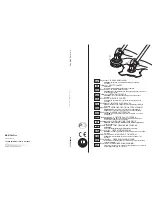
Assembly Guide
5
4.3 When not cutting or gouging, make certain no part of the electrode circuit is
touching the work or ground. Accidental contact can cause overheating and create
a fire hazard.
4.4 Be sure there are no combustible or flammable materials in the workplace. Any
material that cannot be removed must be protected.
4.4.1 Sparks and hot materials from cutting or gouging can easily go through
small cracks and openings to adjacent areas.
4.4.2 Avoid cutting or gouging near hydraulic lines.
4.4.3 Do not cut or gouge tanks, drums or containers until the proper steps have
been taken to insure that such procedures will not cause flammable or toxic
vapors from substances inside. They can cause an explosion even though
they have been “cleaned.” For information purchase “Recommended Safe
Practices for the Preparation for Welding and Cutting of Containers and
Piping That Have Held Hazardous Substances”, AWS F4.1 from the American
Welding Society (see address above).
4.4.4 Vent hollow castings or containers before heating, cutting or gouging. They
may explode.
4.5 Do not add fuel to engine driven equipment near an area where plasma cutting or
gouging is being done.
4.6 Connect the work cable to the work as close to the cutting or gouging area as
practical. Work cables connected to the building framework or other locations
away from the cutting or gouging area increase the possibility of the current
passing through lifting chains, crane cables or other alternate circuits. This can
create fire hazards or overheat lifting chains or cables until they fail.
4.7 Hydrogen gas may be formed and trapped under aluminum work pieces when
they are cut underwater or while using a water table. DO NOT cut aluminum alloys
underwater or on a water table unless the hydrogen gas can be eliminated or
dissipated. Trapped hydrogen gas that is ignited will cause an explosion.
4.8 Read and follow NFPA 51B “ Standard for Prevention During Welding, Cutting and
Other Hot Work”, available from NFPA, 1 Batterymarch Park,PO box 9101, Quincy,
Ma 022690-9101.
5.
CYLINDER may EXPLODE if damaged.
5.1 Use only compressed gas cylinders containing the correct gas for the process used
and properly operating regulators designed for the gas and pressure used. All
hoses, fittings, etc., should be suitable for the application and maintained in good
condition.
5.2 Always keep cylinders in an upright position securely chained to an undercarriage
or fixed support.
5.3 Cylinders should be located: • Away from areas where they may be struck or
subjected to physical damage. • A safe distance from plasma cutting or gouging,
arc welding operations and any other source of heat, sparks, or flame.
Cylinder
Explosion
Содержание Growth Series
Страница 11: ...Assembly Guide 1 Safety Information ...
Страница 21: ...Assembly Guide 11 Receiving and Preparation ...
Страница 33: ...Assembly Guide 23 Assembling the cutting table ...
Страница 43: ...Assembly Guide 33 Binding the Accumove 2 ...
Страница 56: ...Torchmate Growth Series 46 ...
Страница 57: ...Assembly Guide 47 Coupling the water table optional ...
Страница 69: ...Assembly Guide 59 Deploying the Plasma Cutter ...
Страница 88: ...Torchmate 2x2 Growth Series 78 ...
Страница 89: ...Assembly Guide 79 Maintenance and Parts ...
















































